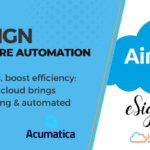It can be a real nightmare for Companies that are switching over or migrating from old legacy systems like Sage, Everest, desktop based ERP to modern cloud based systems like Acumatica.
There are 3 key reasons why Enterprise Resource Planning (ERP) implementation fails. In this blog article we will share some of our experiences and give tips on how to spot bad implementations and how to recover and have a successful implementation.
Top three key reasons for failure
- People/Human Resources
- Complex Business Processes
- Software/Business Solution
#3 – Software/Business Solution
Software is a piece of logical expressions coded in certain machine language allowing us to manage routine tasks and help us in automating and improving productivity and efficiency.
If you were to open your browser and key in Google.com and then start searching for keywords or key phrases, only to result in un-related search results, would you trust that search engine? Hell No, the point is that we are expecting the software to do certain tasks that we perceive it would accomplish, but we could be wrong in understanding what keyword or key phrase to search for so it finds a better match, secondly the search engine might not have adapted to new search terms.
In an ERP system we expect the business solution to perform certain tasks and allow users to perform activities related to their business across the entire organization such as creating sales order, purchase order, manage inventory, capture credit card, invoice, send emails and update financial records to print profit & loss or balance sheet reflecting the business transactions throughout the financial year.
#2 – Complex Business Process
The most critical part of Implementation is understanding your business process, if your implementer doesn’t spend minimum of 10 hours of identifying your organization structure, your current business process or workflows or procedure then your bound to have a failure down the road.
It’s quite essential to understand how your Company operates today from Financial Chart of Accounts (COA), do we need segmented accounting, do we need sub-accounts, what’s quite important for your organization to capture financial data, identify the accounting needs.
How does your sales people communicate with outside world? Does your sales people have a pipeline management, what’s your standard operating procedure from cash to invoice, how do you ship and manage your inventory, warehouse and returns.
This is where the complexity begins and a good implementation team can work through this, understand and map all the ERP features and get you setup.
#1 – People/Resource Management
Why is this the top the list of reasons for failure? In our experience people or human or resource management is the important piece of this puzzle or for being successful.
It starts from the business owner, his/her participation is quite important no matter how busy schedule you have, get involved if not 100% atleast 10% in setting the direction for the business.
Second the executive team needs to be involved during discovery process, if we don’t get to hear during our discovery and we run into them during implementation or go live then it’s too late you already destined for pit-fall.
Involve everyone during the discovery process, sales, customer service, production, shop-floor, shipping, warehouse, accounting, purchasing, vendors and employees. It’s quite important to involve all resources for a successful ERP implementation.
In our experience over 20+ yrs of ERP implementation we found these 3 reasons why implementation fails or succeed and I hope this article enforced your thoughts and I want to leave you all with few take away below.
For Successful Acumatica Implementation
Take away from this article, in order to experience successful ERP implementation you need to organize yourself with these thoughts and actionable items
- Create a RFI (Request for Information) document within your organization
- Communicate with all stake holders, subject matter expertise and key influencers
- Work with experienced and trusted partners in specific fields or industry or niche business models (InfoSourcing we understand Distribution business in Print, Jewelry industries)
- Identify Partner’s strengths and weakness, experienced staff members who will be part of the project from get-go, from sales all the way to support.
- Define your business objectives and specific requirements to run your business
- Identify all customization requirements, the features specific product might not have
- Demo the product from your business stand point, see all features it offers
- Don’t use the words such as “Everything”, “All features” while trying to define your requirements (example: I need all purchasing features, I thought we get everything etc).
- Don’t assume, ask questions, ask one more time, consultants are there to answer them, partners help you answer such questions
- Be reasonable, don’t set false expectations in terms of time, effort and money. Respect Consultants time/effort and negotiate the cost
- Provide scope for expansion in your agreement, both parties need to understand this scope and phases







